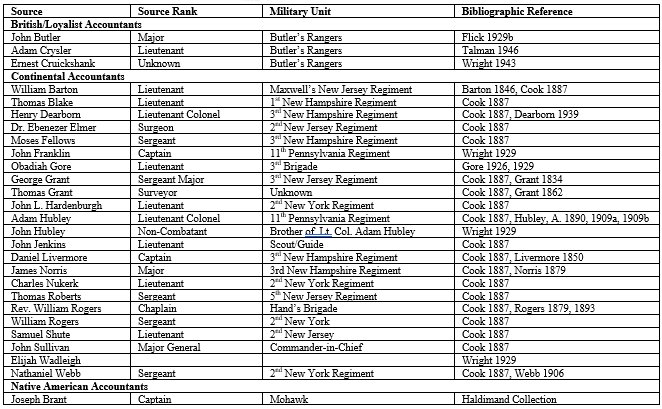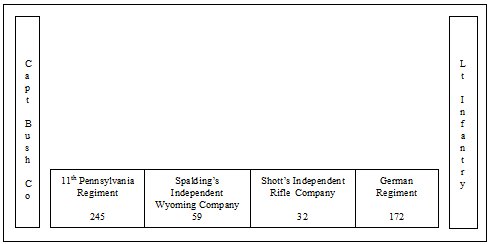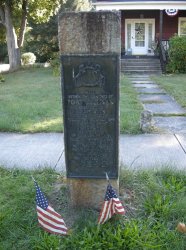IV. Results of Documentary Research
4.1 Introduction
The following will not be an exhaustive study of the overall history of the battle of Chemung as described by the historic record and its historians, this chapter is meant to give the reader a general overview of the battle and how it played out on the landscape. The intent of this project was to give a more balanced account of the battle and to identify the 18th century landscape features to assist in an accurate and meaningful historic preservation plan. The research to date has identified 27 accounts of the battle as it unfolded (Table 1, below).
Table 1. Published and Unpublished Eye Witness Accounts Reviewed.

The on-going research of the battle of Chemung will most definitely bring forward more eye witness accounts not yet identified. The following sections present a narrative time line for the Battle.
4.2 Timeline
Prelude
From the outset of the Sullivan-Clinton operation, the Continentals had met very little opposition from Native or Loyalist forces on route. Along the entire journey the expedition fulfilled the orders of General George Washington by burning every Native and Loyalist home and outbuilding along with food stuffs either in storage or in the fields. Clinton's forces moving downstream and Sullivan's force moving upstream on the Susquehanna River converged at [text deleted] Tioga Point. Detachments from each of the regiments were formed into work parties and tasked with the construction and garrison of a new fortification to be called Fort Sullivan.
In the late morning of August 12th, Captain Cummings and his scout report that a large settlement called Chemung [text deleted]. Upon receipt of this intelligence General Sullivan convened a War Council to immediately set out and destroy the village and fields. By 8 p.m the attacking force was moving out of Fort Sullivan.
Phase I: The March
The Continentals departed Tioga Point in the evening with approximately 1,400 rank and file: the Light Corps, under the command of General Hand, as a vanguard; followed by Generals Poor and Maxwell's Brigades, forming the main body; and the reserve corps under the command of Major General Sullivan. During the War Council, Sullivan had decided to advance under the cover of darkness and take the village and its occupants by surprise at first light. However, the night was reported to be "excessively dark, and want of proper guides" made the march difficult (Cook 1887:151). Progress was slowed even more by uneven terrain and defiles, which required troops to cross in single file. The plan to reach Chemung by daybreak was not to be achieved at the slow rate of the Continentals.
By daybreak "disagreeable emotions" were felt between command and the scouts who were having difficulty locating the village (Cook 1887:151). Scouts discovered a few huts which were surrounded. But these huts were empty, most likely a village named Old Chemung. [text deleted]
Phase II: Opening Assault
Sullivan's attack was to come down hard upon any occupants once the village was surrounded. He first ordered a regiment of Light Corps and a regiment from the main body to cross the River south of the village to cut off any possible escape that way. The remainder of the Light Corps, which included the Independent Rifle Company, led by Captain Anthony Selin, and the Independent Wyoming Company commanded by Captain Simon Spalding, were joined by Lieutenant Colonel Adam Hubley's 11th Pennsylvania Regiment, commanded by General Hand, and they were tasked with making the main assault. General Poor was ordered to bring the remaining Regiment forward in support of General Hand.
The assaulting forces quickly entered the village and spread out looking to engage any defenders. The village was found to be abandoned. Its inhabitants had been warned by scouting parties of the approaching army and removed their possession and stock to the west. As was to be the case throughout the campaign, no Native village was ever taken in a surprise assault.
General Hand advanced his Light Corps, under the command of Captain George Bush, west of the village along a trail leading to the next village called Newtown. [text deleted] Light Corps discovered a small camp with smoldering fires and animal skins (bedding), the personal items of a small rearguard left to scout the actions of Sullivan's raid on the Village of New Chemung. Relaying the discovery back to command General Hand pushed west along the trail in the hopes of making contact with the enemy. Captain Walker commanded a vanguard of 24 men, followed by Lieutenant Colonel Adam Hubley in command of the 11th Pennsylvania Regiment, followed by the two Independent Companies. With the river guarding the left flank of the Regiment, Captain Bush was tasked in guarding the right flank with 40 men. In this order the patrol moved further along the trail (Cook 1887:263).
Research conducted on the Albert Hazen Wright papers located at Cornell University has been used to illustrate the number of soldiers which marched from Tioga to Chemung. Professor Wright made a lifelong study of the Sullivan Expedition. In 1943 he published The Sullivan Expedition of 1779-Contemporary Newspaper Comments, and in 1965 Prof. Wright published The Sullivan Expedition of 1779-Regimental Roster of Men, a listing of over 5,865 men who served on the Sullivan Campaign. Table 2 (below) presents the 11th Pennsylvania Regiment duty roster, as reported to Third Brigade Commander, General Edward Hand, at Wyoming, Pennsylvania in late July, 1779. The 11th Pennsylvania Regiment had a total of 313 soldiers on the roster, with 249 present and fit for duty (Wright papers 1929, Vol. IV).
Table 2. Duty Roster of the 11th Pennsylvania Regiment, July 1779.

Table 3 (below) presents an approximate accounting of the entire Third Brigade (Wright papers: Vol. IV, Wright 1965:4).
Table 3. Third Brigade, Commanded by General Edward Hand.

Wright's research indicated that approximately 1,400 soldiers were under the command of General Hand on the march from Wyoming to Tioga. The number of men Hand mustered out for the attack on Chemung is not reflected in the pre-campaign rosters.
The formation of General Hand's Light Corps, who were advanced from Chemung, most likely followed an Order of March similar to the following description recorded in an orderly book dated July 31, 1779:
Order of march for the Light Corps from Wyoming to Tioga. The 11th P. Regt. & Captn. Spalding's Comp'y will advance by Platoons from the Left and form a Collum to march on the Main Road. The German Reg't & Capt. Shotts Corps will form a Collum to right of the German. - and march a Conveanent Distance on the right having its right flank covered by one Thirth of the Light Infantry of the 11th P. Regt. & the riflemen of Captn. Shotts Corps. Marching Indian file. Two third of the Light Infantry of the 11th P. Regt. & the Riflemen of Capt. Spalding's Company will march in Indian file on the Left of the Grand Collumn to cover its left flank and answer the purpose of a Third Collumn and flanking party to advance a party in front proportioned to its Strenth" (Collward 2009).

Figure 3. The Order of March adapted from Collward (2009).
As the advance party left Chemung Lt. Colonel Hubley notes that the Light Infantry is the vanguard, followed by the 11th Pennsylvania Regiment, Captain Bush's Company on the right flank, and the Independent Companies in the rearguard (Cook 1887:151).
Phase III: Ambuscade
The vanguard had moved [text deleted] past the enemy rearguard encampment. The flat valley bottom plain soon gave way to a steeply rising slope on the right of the patrol. Captain Walker's vanguard did not detect a small group of 20 to 40 Delaware warriors, led by Captain Rowland Montour, quietly awaiting the larger Continental patrol probing west of Chemung (Smy 2009 [Brant 1779; Butler 1779]). Walker's vanguard received a sudden volley of fire from the warriors on heights. Captain Bush on the right flank had not yet reached the rising slope at the time of the first volley. He quickly moved forward moving along the north side of the ridge in an attempt to outflank the enemy ambush. Hubley commanded the regiment to form right in preparation to return fire and assault the enemy position at the top of the steeply sloping hillside. The 11th Pennsylvania and the Walker's vanguard quickly advanced up the hill under fire. Bush's right flanking of the Delaware position did not go unnoticed. Montour called for the retreat of the warriors from the ambush position down from the ridge along a gentle slope. Hubley and Bush were unable to give chase as Captain Montour and the Delaware swiftly melted away into heavy vegetated, low lying wetlands northwest of their ambush position, which "favored they [sic] retreat, and prevented our pursuing them" (Cook 1887:152).
Phase IV: Regrouped and Reengaged
The ambush and continued firefight with the Delaware warriors left the Continentals with their first substantial battle casualties in this campaign. The first volley had ripped through the right flank of the vanguard killing a sergeant, four privates, and a drummer. By the end of the action, two captains, one adjutant, one guide, and eight privates from the Continental forces were wounded. The Lieutenant Colonel Hubley's report on the action was unable to report if any of the enemy had sustained casualties, as "according to custom, previous to our dislodging them, carried off their wounded and dead (Cook 1887:152)." Major Butler and Captain Joseph Brant reported that only one warrior was killed in the action (Flick 1929b; Smy 2009). After securing the skirmish area, the Continental patrol returned to the Village of Chemung to assist in the firing of the buildings and crops.
As the morning wore on a contingent of soldiers were dispatched across the river to cut and burn a large field of corn. After the [text deleted] march through the previous night and the early morning action the companies guard was down, as it appears sentries or pickets were not posted. A small, unknown number of Warriors, most likely the same responsible for the Ambuscade approached on the opposite bank of the river. From their sniping position, they fired a well aimed volley into the Continental's who were focused on the task at hand. The Continentals returned fire, but the small war band quickly retired without a loss.
Phase V: Withdrawal
By early afternoon the tasks of destroying the village of Chemung and surrounding fields were complete. In preparation of the expedition's return to Chemung, Sullivan ordered [text deleted] be left standing for resupply of the Army. The dead and wounded were placed on horseback for transport. Sullivan immediately ordered the withdrawal of his forces back to Tioga. The soldiers began the long march back to Fort Sullivan. An account first published in The Pennsylvania Gazette and Weekly Advertiser on August 25, 1779 details that "a greater and more difficult march never was performed; in a 24 hours we marched [text deleted] through a wild and mountainous country (Wright 1943: 47)." [text deleted]
The following day a memorial was given for those killed in the action of August 13th. A grave was excavated within the confines of Fort Sullivan (Photo 1).
The Aftermath
Continental losses were reported with varied estimates ranging from 6 to 67 killed, which was dependent on each recorder and their own bias. Albert Hazen Wright compiled 48 accounts from Journals, orderly books, diaries, letters, and newspaper accounts (Wright 1943). He found that some entries only recorded six deaths from the initial ambush and do not account for the one man killed in the afternoon. Accounts vary in the number of wounded ranging from five or six to as many as 14 total. The majority of the accounts note seven killed (six at the ambush and one in the cornfield). Is there something to be ascertained from the variations in casualty reports that make up the other accounts?
An account of the action written by Major Marshall to his brother, dated August 15, 1779 and first published in The New York Journal and General Advertiser on August 30, 1779 indicates that something scandalous had occurred in the field.
It appeared that the enemy had gone off that morning, in consequence of which our light corps, commanded by General Hand, pursued the road up the river about two miles, where he was fired upon by about 20 Indians from behind some bushes, who immediately fled. Our loss is six privates killed, and two officers and four privates wounded, chiefly by the fire of our own men [emphasis added by Wright] (Wright 1943a:46).
There is no mention of the firefight in the cornfield later in the morning. Nor has any other account indicated that the casualties were the result of "friendly fire". It is difficult to ascertain if a friendly fire incident did occur, as there is only one account that mentions it. If it did happen, how many actually were injured by their unit? There is no way to know for certain. Lieutenant Colonel Charles R. Schrader in his 1982 study Amicicide: The Problem of Friendly Fire in Modern War notes that:
the researcher must collect and analyze the scattered, often cryptic, references to amicicide found in general operational military histories or in the available official documents of combat units . . . Commanders may be reluctant to report instances of casualties due to friendly fire because they are afraid of damaging unit or personal reputations, because they have a misplaced concern for the morale of surviving troops or the benefits and honors due the dead and wounded, or simply because of a desire to avoid the unprofitable conflicts with personnel of supporting or adjacent units (Washabaugh 1992).
These incidents are caused by factors such as, visibility, type of tactical operation in progress, the type of weapon being used, and the degree of coordination between units. The most common cause attributed to friendly fire incidents, on a modern battlefield, is direct human error caused by fear, inexperience, and the inherent chaos of battle (Washabaugh 1992). The battlefield environment was wooded with an early morning sun, creating low visibility in the brush. Soldiers fighting on unfamiliar ground can become disoriented more easily than on familiar terrain. The direction from which enemy fire comes may not be easy to identify, and combat stress may add to the confusion, especially if fire is exchanged. The stress and exhaustion of the forced night march and suddenness of the Delaware attack could all be considered contributing factors if "friendly fire" casualties did occur.
Conclusions
The Battle of Chemung, to the participants and to later historians, is viewed as a very minor engagement, hardly worth mention in many accounts. The mission goals were to destroy the Village of Chemung, with all its inhabitants in the early dawn of August 13th. General Sullivan and Staff organized and executed a [text deleted] march through the wilderness from Fort Sullivan at Tioga Point to the outskirts of Chemung with almost 1,400 soldiers. Enemy scouts discovered the approach of the Continentals and warned inhabitants with time for evacuation west towards Newtown.
Chemung was destroyed, but General Sullivan and his Staff were dealt their first battlefield casualties of the campaign. The Light Infantry, commanded by General Hand, continued the advance from the Village west in pursuit of the retreating inhabitants. Once in position, a rearguard of Delaware warriors led by Captain Montour ambushed Hand's troops. An exchange in fire and a bayonet charge broke the cohesion of the Native attackers. With little chance of bringing the Crown-allied Haudenosaunee and other Native warriors to battle, Sullivan called off the pursuit ordering Hand to return to Chemung.
Later that day, soldiers from the New Jersey regiments were sent across the river from the Village to cut and burn a large cornfield. While performing this duty, a small party of enemy warriors began shooting from a position across the river from the work party. The snipers were quickly driven off and the casualties evacuated back to the remnants of Chemung.
Sullivan returned late that evening having completed the mission. He was anxious to link up with General Clinton's forces moving southwest along the Susquehanna River. On Aug 15th a detachment of 900 men was sent up the Susquehanna to meet Clinton. The increased numbers would allow Sullivan to sweep west and north into the Finger Lakes Region. The importance of the Battle of Chemung should not be measured in the number of shots fired or how long the engagement lasted, but rather it stands as a prequel to the Battle of Newtown 16 days later.

Figure 4. This page/map was intentionally deleted per the requirements of the Archaeological Resource Protection Act (16 U.S.C. 470hh) and its implementing regulations (49 FR 1027, Jan. 6, 1984).